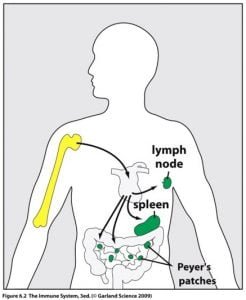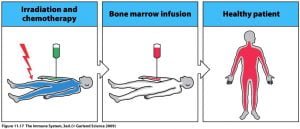- PRIMARY
- Bone marrow and thymus
- SECONDARY
- Lymph nodes and spleen.
Bone Marrow
- Located in the middle of bones, most specifically vertebrae, pelvic, and leg bones, it generates blood cells — cells that travel throughout the body in the blood and tissue fluids.
- Constant supply of Stem Cells
- Maturation and selection of B cells takes place here, B cells express IgM and IgD while in Bone marrow
- Elimination of B-lymphocytes that could participate in autoimmune reactions
- Each B-cell acquires unique specificity for one antigen (via surface IgM receptor)
- Bone Marrow Transplant – can replace a completely destroyed immune system

Thymus
- Located in the front of the upper chest, behind upper part of sternum
- Consists two lobules, each consisting many lobules.
- Attains maximum at birth and gradually decrease in size with aging.
- Secretes thymosin, a peptic hormone, that matures T cells
- It acts like a nursery for the development of T cells. Development of T-lymphocytes take place here (stem cells migrate from bone marrow to thymus).
- Each T-lymphocyte and each B-lymphocyte (in bone marrow) are uniquely specific for only one antigen
- Receptors bind to the antigen for which they are specific.
Lymph nodes
- These nodes filter lymph fluid, removing antigens, bacteria, and cancer cells that get trapped in their weblike
 structure, where macrophages, antibodies, and T cells can destroy them.
structure, where macrophages, antibodies, and T cells can destroy them. - Hundreds of lymph nodes are located throughout body, so removing any lymph nodes during surgery does not compromise overall lymph node protection.
- Uniquely designed to optimize cell interactions during immune responses
- Scattered throughout body
Spleen
- Located in the upper left side of abdomen, it filters out foreign organisms that infect blood, removing old or damaged platelets and red blood cells, storing extra blood cells and releasing it as needed.
- The spleen can be removed if it is damaged, but that may lower resistance to infection.
- Mature lymphocytes reside and function
- Design optimizes cell interactions
Gut-associated Lymphoid Tissue (GALT)
- Located along the small intestine (also referred as Peyer’s patches)

- Lymphocytes maturate, reside and function
- Responds to antigens (e.g., bacteria) in the intestinal tract
- Designed to gather antigens from the intestinal tract and optimize cell interactions
 structure, where macrophages, antibodies, and T cells can destroy them.
structure, where macrophages, antibodies, and T cells can destroy them.
